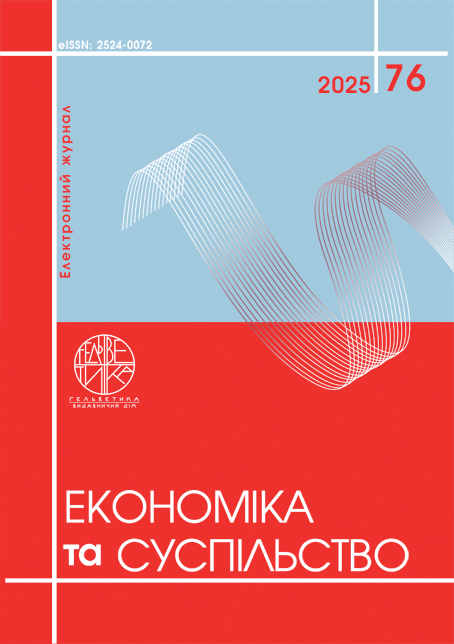CREATIVE MANAGEMENT OF TOURISM DEVELOPMENT IN NATURAL PROTECTED AREAS: STRATEGIES, MANAGEMENT SOLUTIONS AND DIGITAL TECHNOLOGIES
Abstract
In the context of rising demand for environmentally oriented forms of tourism, natural protected areas are becoming not only objects of environmental preservation but also promising tourist destinations. This article aims to substantiate conceptual foundations and practical approaches to creative tourism management in natural protected areas of Ukraine. The study addresses the urgent need for management strategies that balance biodiversity conservation and ecosystem integrity with the development of local economies and tourism appeal. Traditional management models often neglect the ecological fragility of these territories, necessitating innovative and creative approaches aligned with sustainable development principles. The study revealed that effective tourism governance in protected areas requires a participatory approach involving local communities, businesses, and environmental organizations. Among the proposed creative management solutions are dynamic pricing based on visitor flow and ecological capacity, the development of specialized tourism products, gamification for environmental awareness and the use of digital tools such as mobile apps, satellite monitoring, and augmented reality. International experience, particularly from the U.S. and EU countries, demonstrates the effectiveness of participatory planning and digital technologies in managing tourist flows and minimizing anthropogenic pressure. The practical value of the article lies in offering a strategic vision for the sustainable development of tourism in Ukraine’s natural protected areas in the post-war recovery context. The recommendations include developing a national ecotourism strategy, implementing digital management platforms, and promoting public-private partnerships. Emphasis is placed on green finance, environmental certification, local capacity building and ecosystem-based planning. The article concludes that creative tourism management, supported by adaptive strategies and technological innovations, is essential to ensuring the long-term sustainability of both natural heritage and regional development. Future research should focus on evaluating the effectiveness of specific creative solutions across different types of natural protected areas.
References
Washington H., Baillie J., Waterman C., Milner-Gulland E. J. A Framework for Evaluating the Effectiveness of Conservation Attention at the Species Level. Oryx. 2015. Vol. 49 (3). pp. 481-491. DOI: https://doi.org/10.1017/S0030605314000763
Hall C. M., Gössling S., Scott D. The Evolution of Sustainable Development and Sustainable Tourism. In: Hall C. M., Scott D., Gössling S. (Eds.) Handbook of Tourism and Sustainability. Routledge, 2015. pp. 16-35.
Honey M., Krantz D. Global Trends in Coastal Tourism. Washington, 2007. URL: https://www.responsibletravel.org/wp-content/uploads/sites/213/2021/03/global-trends-coastal-tourism-cesd-2008.pdf
Миронов Ю. Б., Пугачов М. І., Корінець Р. Я. Інноваційні напрямки управління екологічним туризмом в Україні в контексті сталого розвитку. Інфраструктура ринку. 2024. Вип. 77. С. 128-134. DOI: https://doi.org/10.32782/infrastruct77-23
Mandić A. Nature-Based Solutions for Sustainable Tourism Development in Protected Natural Areas: a Review. Environment Systems and Decisions. 2019. Vol. 39, pp. 249-268. DOI: https://doi.org/10.1007/s10669-019-09718-2
Міністерство захисту довкілля та природних ресурсів України. URL: https://mepr.gov.ua/
Martinić I., Sladonja B., Zahtila E. Development Prospects of the Protected Areas System in Croatia. In: Protected Area Management. IntechOpen, 2012. DOI: https://doi.org/10.5772/50482
Wang X. Research Review of the Ecological Carrying Capacity. Journal of Sustainable Development. 2010. Vol. 3 (3), pp. 263-265. DOI: https://doi.org/10.5539/jsd.v3n3p263
Washington, H., Baillie, J., Waterman, C., & Milner-Gulland, E. J. (2015). A Framework for Evaluating the Effectiveness of Conservation Attention at the Species Level. Oryx, 49 (3), 481-491. DOI: https://doi.org/10.1017/S0030605314000763
Hall, C. M., Gössling, S., & Scott, D. (2015). The Evolution of Sustainable Development and Sustainable Tourism. In: Hall, C. M., Scott, D., & Gössling, S. (Eds.). Handbook of Tourism and Sustainability. Routledge, 16-35.
Honey, M., & Krantz, D. (2007). Global Trends in Coastal Tourism. URL: https://www.responsibletravel.org/wp-content/uploads/sites/213/2021/03/global-trends-coastal-tourism-cesd-2008.pdf
Myronov, Yu. B., Pugachov, M. I., & Korinets, R. Ya. (2024). Innovatsiyni napryamky upravlinnya ekolohichnym turyzmom v Ukrayini v konteksti staloho rozvytku [Innovative Directions of Eco-Tourism Management in Ukraine in the Context of Sustainable Development]. Infrastruktura rynku, 77, 128-134. DOI: https://doi.org/10.32782/infrastruct77-23
Mandić, A. (2019). Nature-based Solutions for Sustainable Tourism Development in Protected Natural Areas: a Review. Environment Systems and Decisions, 39, 249-268. DOI: https://doi.org/10.1007/s10669-019-09718-2
Ministerstvo zakhystu dovkillya ta pryrodnykh resursiv Ukrayiny [Ministry of Environmental Protection and Natural Resources of Ukraine]. URL: https://mepr.gov.ua/
Martinić, I., Sladonja, B., & Zahtila, E. (2012). Development Prospects of the Protected Areas System in Croatia. In: Protected Area Management. IntechOpen. DOI: https://doi.org/10.5772/50482
Wang, X. (2010). Research Review of the Ecological Carrying Capacity. Journal of Sustainable Development, 3 (3), 263-265. DOI: https://doi.org/10.5539/jsd.v3n3p263

This work is licensed under a Creative Commons Attribution 4.0 International License.


